Sixpence (Australian)
The Australian Sixpence circulated from 1910 up until the decimalisation of Australian Currency in 1966. The coins were initially minted in England; however, Australia began to mint their own from the year of 1916 at branches of the Royal Mint in Sydney and Melbourne (Wilson 1945, pp. 557). The coins which made up Australia's pre decimal currency were identical to British currency in the characteristics of weight and size. The Coinage Act of 1909–1947, authorised the issue of Australian coins in the select denominations, including the Sixpence (Wilson 1945, pp. 557). By 1916 all silver denominations, including the Sixpence, were able to be minted at the Royal Mint branch in Melbourne (Pitt 2017, pp. 44). The Decimalisation of Australian currency in 1966, resulted in the introduction of a currency unique to Australia.

At the time of the Sixpence, Australian lives were ‘very English’ (Murphy 2016). “The money ran through nursery rhymes up to Shakespeare; on the land, "a pound for a pound" meant good news for wool growers; two-up schools needed pennies to play; and slang words for the money, zac, traybob, deena, and quid, littered the language” (Murphy 2016).
Origin

On 1 March 1910 The R.M.S Otranto arrived in Sydney carrying the initial shipment of Australian Commonwealth Silver shillings from the Royal Mint, London[1] Other coins, including sixpence, arrived later in the year, completing the set of new Australian silver currency. The first Australian coins that were shipped bore the bust of Edward VII, whom had died before the coins reached Australia.[2]
Within the interval of Australian history, it had appeared that there had been great leaps forward for Australia. The Commonwealth of Australia was formed in 1901, with the six self-governing colonies joining together.[3]
The establishment of the Commonwealth in 1901, meant the Australian currency consisted of gold, silver and bronze coins from the United Kingdom .[4] At the beginning of circulation, the Sixpence was identical to that of the British in "weight and fineness".[5] The Coinage Act of 1909 resulted in Australian coins being introduced as a legal tender in the forms of Sixpence, florin, shilling, threepence, penny and half penny.[6]
The 1909 Act, required that batches of silver coins should be 925 fine, meaning that in every 1000 coins, 925 should be silver and the rest copper alloy.[7]
The origin of the word Sixpence is derived from saxpence[8] Another term for the Sixpence is "zac", which was first recorded in Australian English in the 1890s. It was also used to mean "a trifling sum of money".[9] Although the sixpence is no longer in use within Australia, the word "zac" is still used within Australia with fond memories.[10]
Designs

It is considered a tradition that the direction in which the British Monarchs face on their coins should change with each reign (Hanley and James 1966, pp. 86). This tradition is believed to have begun with Charles II who refused to have his portrait painted the same way as Oliver Cromwell (McDonald 1983, pp. 47). It was defines as Charles II's way to turn his back towards the man who beheaded his father (McDonald 1983, pp. 47).
The Australian Sixpence bore an unchanged design for 50 years, bearing a record as the coin which was least changed (Hanley and James 1966, pp. 97). The final Sixpence minted in 1963 in Melbourne had the same reverse as the first ever coin struck in 1910 in London (Hanley and James 1966, pp. 97).
1910: The obverse of the Sixpence in circulation during 1910 had Edward VII crowned and robed facing the right, and the Arms of the Commonwealth of Australia on the reverse, as authorised by the Royal Warrant (Pitt 2017, pp. 44). William DeSaulles, the Chief Engraver at the Royal mint, designed the obverse of the Edward VII sixpence (Lane 2008, pp. 11). DeSaulles initials DES appear at the base of the 1910 sixpence (Hanley and James 1966, pp. 86).
1911-1936: The coins arrived in Australia after King Edward VII died. When the King died in 1910, George V ascended the throne. The coins minted after 1911, had George V crowned and facing the left on the obverse (Pitt 2017, pp. 44).
1938-1952: George VI came to the throne on 10 December 1936, after Edward VIII's abdication (Pitt 2017, pp. 44). The Royal Mints impressed nature associated with Coin designer, Thomas High Paget's job on the 1935 Prince of Wales commemorative medal, led Paget to be asked to join the competition for the new coins for Edward VIII ascension to the throne (Lane 2008, pp. 14). Paget's design was successful in being picked, however was never used or issued after Edward VIII's abdication. Paget created a new designed with was used for the commemoration of George VI's coronation (Lane 2008, pp. 14). The coin pictured him looking to the left with no crown. The only thing that changed with the George VI coin was the writing on the obverse. Between 1938-1948 and 1950–1952, different words are depicted on the coins, this can be seen in more detail below.
1953: The Death of King George VI in February 1952, led to the ascendance of H.M Queen Elizabeth II to the Throne. Due to this, the Australian commonwealth coinage designs changed to picture a portrait of her majesty on the obverse. The reverse remained the same. (Pitt 2017, pp. 44). Similarly, to George VI coin, the writing depicted on the coin for H.M Queen Elizabeth II changed between 1953-1954 and 1955–1963. More detail can be seen below.
Ultimately, out of all pre-decimal coinage, the Sixpence is the only coin whose reverse was not altered. The reverse consisted of a coat of arms approved by Edward VII in the year 1908 (Hanley and James 1966, pp. 86).The main feature of the arms, was a shield derived from the Australian Coat of arms, which was supported by a kangaroo and an emu and a seven pointed star as the crest, as well as the words ‘Advance Australia’ on the scroll underneath (Hanley and James 1966, pp. 86). This is considered surprising as the 1908 Coat of Arms Symbol was changed in 1912 within Australia, and as such was obsolete for most of the pre-decimal currency period (Online Coin Club 2015). The new version of the Coat of Arms did not appear in the correct form until the 1966 50 cent piece (McDonald 1983, pp. 47).
The Commonwealth Treasury mintage figures show that in 1951 13 760 000 Sixpences were issued in 1951 (Hanley and James 1966, pp. 9)These coins were produced at the Melbourne Mint, however when looking closely with a magnifying glass, there is an engraving of the letter PL, which is a mintmark demonstrating that the coin was struck at the Royal Mint in London (Hanley and James 1966, pp. 9)
Value
The 1918 Sixpence is the rarest and most valuable which is considered to be worth $40AUD in E F (extremely fine) condition and $200 AUD in an uncirculated condition (Hanley and James 1966, pp. 97)
The Sixpence in the years of 1916, 1917, 1912, 1920, 1914 and 1911 are also rare ones, with 1935 and 1924 coins being scarce (Hanley and James 1966, pp. 97).
Uncirculated: (Hanley and James 1966), refer to and uncirculated coin as one that has a mint-fresh lustre with a clear detail of the heads of the emu and kangaroo. Magnification should also show no blemishes, and the feathers of the emu should show no trace of wear (Hanley and James 1966, pp. 128)
Extremely fine: In terms of an extremely fine coin (Hanley and James 1966), these are ones which show superficial scratches, of the chutes and conveyors of the machines, as well as having a large deal of their mint lustre remaining.
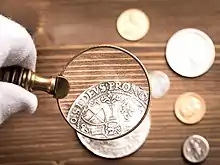
The Sixpence was the most favoured medium of exchange and as such a collector would struggle to obtain all the varieties in good quality, as most were well used and wear was accounted for them (McDonald 1983, pp. 69).
Specifications
| Image | Monarch | Years | Composition | Designers | ||||||
|---|---|---|---|---|---|---|---|---|---|---|
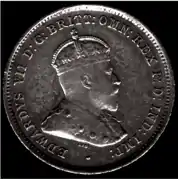 | King Edward VII | 1910 | 92.5% silver, 7.5% copper | Obverse: George W. De Saulles
Reverse: W.H.J. Blakemore | | ||||||
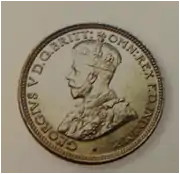 | King George V | 1911-36 | 92.5% silver, 7.5% copper | Obverse: Thomas H. Paget
Reverse: W.H.J. Blakemore | ||||||
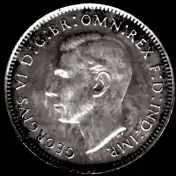 | King George VI | 1938-45 | 92.5% silver, 7.5% copper | Obverse: Thomas H. Paget
Reverse: W.H.J. Blakemore | ||||||
| King George VI | 1946 - 52 | 50% silver, 40% copper, 5% zinc, 5% nickel | Obverse: Thomas H. Paget
Reverse: W.H.J. Blakemore | |||||||
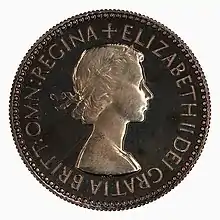 |
Queen Elizabeth II | 1953 - 54 | 50% silver, 40% copper, 5% zinc, 5% nickel | Obverse: Mary Gillick
Reverse: W.H.J. Blakemore | ||||||
| Queen Elizabeth II | 1955-63 | 50% silver, 40% copper, 5% zinc, 5% nickel | Obverse: Thomas H. Paget
Reverse: W.H.J. Blakemore | |||||||
| These images are to scale at 2.5 pixels per millimetre. For table standards, see the coin specification table. | ||||||||||
The decimalisation of Australian currency
In the late 1950s the Decimal Currency committee guided that the Australian government begin to consider to replacement of imperial systems with decimal currency (Reserve Bank Australia 2020). The introduction of a decimal currency would simplify calculations, and increase financial efficiency, eventuating in a positive economic outcome for Australia (Reserve Bank Australia 2020).
Gerard McManus stated in Management Today, February 2014, “After almost 50 years, in terms of implementation of a government program, decimalisation remains arguably one of the most seamless and best executed reforms in Australia’s history” (National Museum Australia 2020).
The decimalisation of Australia's currency was considered to be about much more than just changing the appearance of money, but rather it involved many important principles (Frame 2006). It advanced Australia's economic independence as well as promoted Australian symbols (Frame 2006).
Mintmarks
- D : Denver
- M : Melbourne
- PL : London
- S : San Francisco
References
- (Pitt 2017, pp. 44)
- (Hanley and James 1966, pp. 86)
- (Hanley and James 1966, pp. 85)
- (Wilson 1997, pp. 557)
- (Wilson 1997, pp. 557)
- (Wilson 1997, pp. 557)
- (Hanley and James 1966, pp. 85)
- (Australian National University 2017)
- (Australian National University, 2017)
- (Australian National University 2017)
Sources
- All Coin Values, Sixpence Values, viewed on 1 October, https://www.allcoinvalues.com/australian-coins-and-notes/1955-australian-sixpence-value.html
- Carson, R.A.G 1963, Coins of the World, Harper and Row Publishers, New York, USA.
- Cuhaj, G 2015, Standard Catalogue of World coins: 1801-1900, Krause Publications, United States.
- Frame, T 2006, Dollars helped us grow: [1 All-round Country Edition], Canberra, A.C.T.
- Hanley, T & James, B 1966, Collecting Australian Coins, The K. G. Murray Publishing Company, Sydney, NSW.
- Lane, R. D 2008, Encyclopedia Small Silver Coins, Roger deWardt Lane, United States.
- McDonald, G 1983, Rigby's Australian Coin and Banknote Guide, Rigby, United States
- McDonald, G 1983, Rigby’s Australian Coin and banknote Guide, Rigby Publisher, Australia.
- Meanings and origins of Australian words and idioms, Australian National University, viewed 2 November 2020, https://slll.cass.anu.edu.au/centres/andc/meanings-origins/z
- Michael, T 2020, Standard Catalog of World Coins 2001-Date, Krause Publications, United States.
- Murphy, D 2016, When our pounds changed to dollars, Melbourne, Vic.
- National Museum Australia, Decimal Currency, viewed on 1 October, https://www.nma.gov.au/defining-moments/resources/decimal-currency
- Online Coin Club, Sixpence 1921 - Coin from Australia – detailed information, viewed on 1 October, https://onlinecoin.club/Coins/Country/Australia/Sixpence_1921/
- Pitt, M 2017, Renniks Australian Coin and Banknote Values 29th Ed: The Leading Guide for Australian Coin and Banknote Values, Renniks Publications Pty, Limited, Australia.
- Rabbit, M 1993, The Coin Book: Australian History Through Coins, Hale & Iremonger, Australia.
- Rees, P 2017, Inside the vault: the history and art of Australian coinage, NewSouth Publishing, Australia.
- Reserve Bank of Australia, A New Currency, viewed on 1 October, https://museum.rba.gov.au/exhibitions/the-decimal-revolution/a-new-currency/
- TDK, Australian Sixpence 1910-1936, viewed on 1 October, http://www.tdkapdc.com.au/australian-sixpence-1910-to-1936.html
- Wilson, R 1947, Official Year Book of the Commonwealth of Australia No. 37 - 1946 and 1947, Aust. Bureau of Statistics, Australia.
External links
| Preceded by Sixpence (British) |
Sixpence 1910–1966 |
Succeeded by Five cent coin (Australian) |